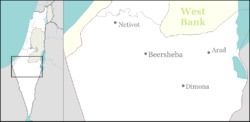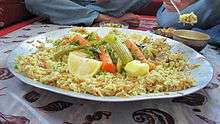Umm Batin
| Umm Batin אום בטין أم بطين | |
|---|---|
|
| |
 Umm Batin | |
| Coordinates: 31°16′49.12″N 34°53′5.47″E / 31.2803111°N 34.8848528°ECoordinates: 31°16′49.12″N 34°53′5.47″E / 31.2803111°N 34.8848528°E | |
| District | Southern |
| Council | Al-Kasom |
| Founded | 2004 |
| Area[1] | 6,000 dunams (6 km2 or 2 sq mi) |
| Population (2015)[2] | 3,080 |
| • Density | 510/km2 (1,300/sq mi) |
| Name meaning | Hidden Mother |

Umm Batin (Arabic: أم بطين; Hebrew: אום בטין) is a Bedouin village in southern Israel. Located in the northern Negev desert, 12 km northeast of Beersheba and adjacent to the highway 60, it falls under the jurisdiction of al-Kasom Regional Council. In 2015 it had a population of 3,080.
Etymology
The village name derives from the Arabic words for mother, umm (أمّ), and hidden, batin (باتين). Translated, Umm Batin can mean either Hidden Mother or Mother of the Hidden. The historical origins of the village name are not well-documented.
History
Prior to the establishment of Israel, the Negev Bedouins were a semi-nomadic society that had been through a process of sedentariness since the Ottoman rule of the region.[3] During the British Mandate period, no legal framework was established to justify and preserve land ownership. Thus Israel’s land policy was adopted to a large extent from the Ottoman land regulations of 1858 as the only legal precedent.[3]
Israel has continued the Ottoman policy of sedentarization of Negev Bedouins. In the 1950s Israel re-settled two-thirds of the Negev Bedouin in an area that was under a martial law.[3] Several townships were built for them, offering better living conditions, infrastructure, sanitation, health and education, and municipal services.
As of today, according to the information of Israel Land Administration, over 60% of the Negev Bedouin live in seven settlements in the Negev desert with approved plans and developed infrastructure: Hura, Lakiya, Ar'arat an-Naqab (Ar'ara BaNegev), Shaqib al-Salam (Segev Shalom), Tel as-Sabi (Tel-Sheva), Kuseife and the city of Rahat, the largest among them.[4] These townships cannot resolve the issue of high population density and illegal construction in the Negev absolutely, so besides expanding existing towns, the Israeli government has decided to construct 13 additional settlements with modern infrastructure for the Negev Bedouin, and Umm Batin is one of them.[5]
The village was established following Government Resolution 881 on 29 September 2003, which created eight new Bedouin settlements (seven of which were to be located in the now defunct Abu Basma Regional Council).[6] It was officially recognized in 2004.[7]
Local government
Formerly part of the Abu Basma Regional Council, Umm Batin currently falls under the jurisdiction of al-Kasom Regional Council. On November 5, 2012 the Israeli Ministry of Interior abolished Abu Basma, splitting it into two smaller regional councils, al-Kasom and Neve Midbar.[8][9]
Prior to its division, Abu Basma Regional Council represented approximately 30,000 people spread across eleven newly recognized Bedouin villages.[10] Along with the dismantling of Abu Basma, the Israeli Interior Minister postponed regional council elections for Al-Kasom and Neve Midbar until 2017.[11] From its inception in 2003 until its division in 2012, Abu Basma Regional Council had been headed by an official appointed by the Interior Minister. The elections - which had been mandated in a ruling by the Israel Supreme Court to take place in December 2012 - would have represented the first democratically elected leadership of the Council.[12]
It is accepted to give all the newly established councils a four-year trial period before elections are held. According to the amendment to the Regional Councils’ Law passed in 2009, that period can be extended by the Israeli Ministry of Interior indefinitely. Following a decision taken by the Kneset’s Interior Committee in 2010 to force the government to present a detailed timeline for the council’s development the date for the first elections in the Abu Basma Regional Council was set as 2012.[13] But due to the unpreparedness and low level of municipal services eventually these elections were delayed once again and never took place due to the regional council's abolition.
Demography
The residents are mainly of two tribes: Abu Kaf and Abu Assa.
Education
Umm Batin has four schools, serving kindergarten through twelfth grade: Abu Kaf and Al-Sanabel Elementary Schools, Awrat Secondary School, and ORT Umm Batin High School. There were a total of 2,163 students enrolled in Umm Batin schools in 2012.[14] The nearest university is Ben-Gurion University of the Negev in Be'er Sheva.
There is an acting "The English in Umm Batin" program, a result of cooperation between the Ben-Gurion University of the Negev Medical School for International Health, the community of Umm Batin, and the students of ORT Umm Batin High School.[15]
 Al-Sanabel Elementary School
Al-Sanabel Elementary School- Abu Kaf Elementary School
- Abu Kaf Elementary School
 Dirt road through Umm Batin
Dirt road through Umm Batin- Family goat pen in Umm Batin
See also
References
- ↑ Formation of new town for the Negev Bedouin pp.5-7
- ↑ "List of localities, in Alphabetical order" (PDF). Israel Central Bureau of Statistics. Retrieved 16 October 2016.
- 1 2 3 Dor Fridman. "About the Negev Bedouins". LocalEconomySeminar.
- ↑ State of Israel. Ministry of Justice, Ministry of Foreign Affairs. List of Issues to be taken up in Connection with the Consideration of Israel's Fourth and Fifth Periodic Reports of Israel (CEDAW/C/ISR/4 and CEDAW/C/ISR/5)
- ↑ Bedouin information Israel Land Administration
- ↑ Government resolutions passed in recent years regarding the Arab population of Israel The Abraham Fund Initiative
- ↑ National Insurance Institute report, 2009 p.9
- ↑ Press Release, 29 November 2012 Adalah, The Legal Center for Arab Minority Rights in Israel
- ↑ Press Release, 14 November 2012 Abu Basma Regional Council website (in Hebrew)
- ↑ Segmenting the Naqab(Negev): Israel Redistricts to Postpone Local Elections for Arab-Bedouin Citizens Dr. Thabet Abu Ras, October 2012
- ↑ Adalah Briefing Paper, 7 November 2012
- ↑ HCJ 3183/10, Hussein Rafeea, et. al v. The Minister of the Interior, et al.
- ↑ Rebecca Anna Stoil, Bedouin council's first election in 2012 The Jerusalem Post, June 9, 2010
- ↑ Press Release, 26 July 2012 Adalah, The Legal Center for Arab Minority Rights in Israel
- ↑ English in Umm Batin student blog
External links
- Umm Batin Abu Basma Regional Council (Hebrew)
- ORT Umm Batin and the High School for Environmental Studies in the Negev
- Lands of the Negev, a short film by Israel Land Administration describing the challenges in providing land management and infrastructure to the Negev Bedouin
- Bedouin information Israel Land Administration
- Seth Frantzman, Presentation to Regavim about Negev
